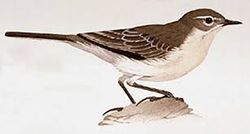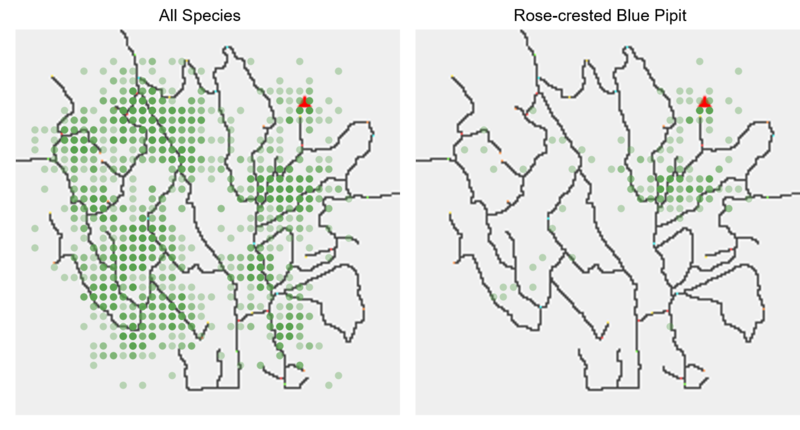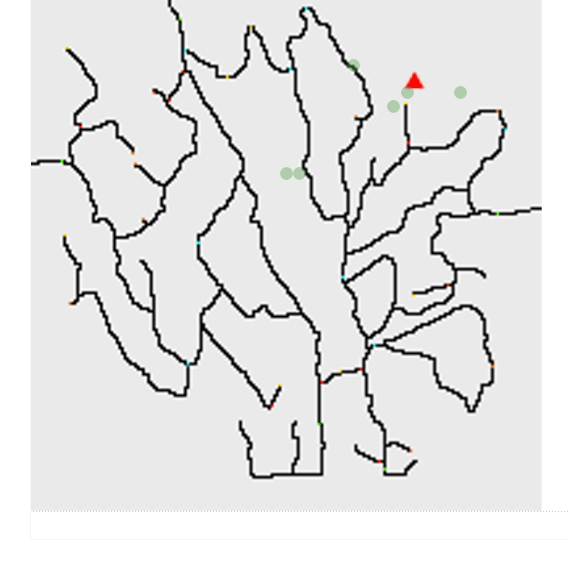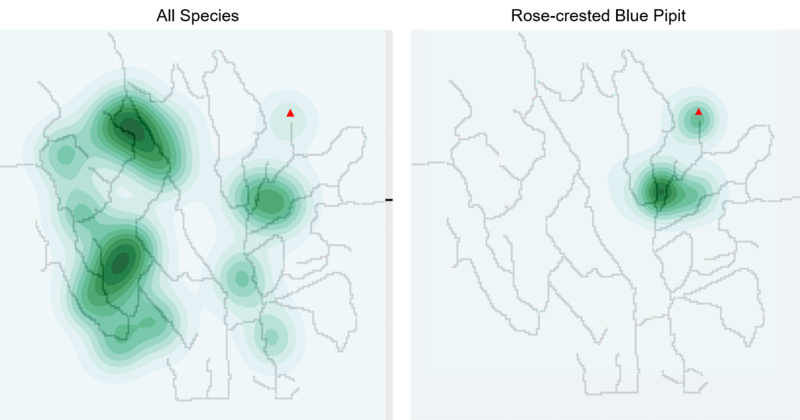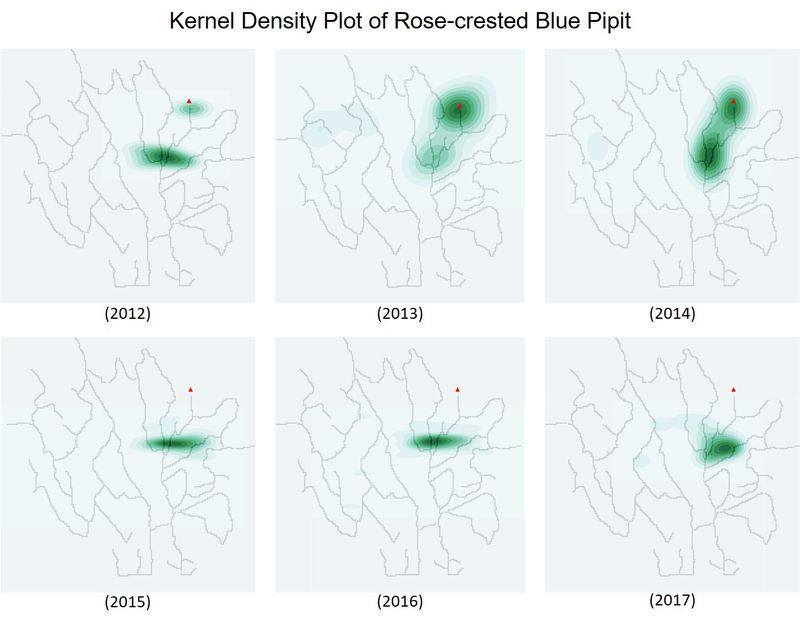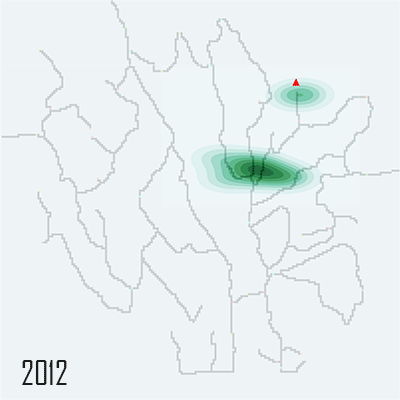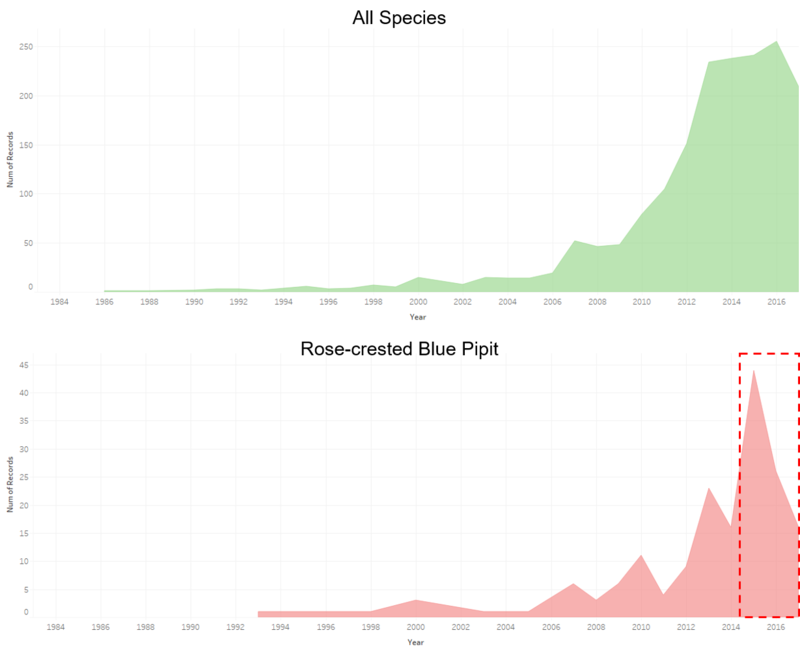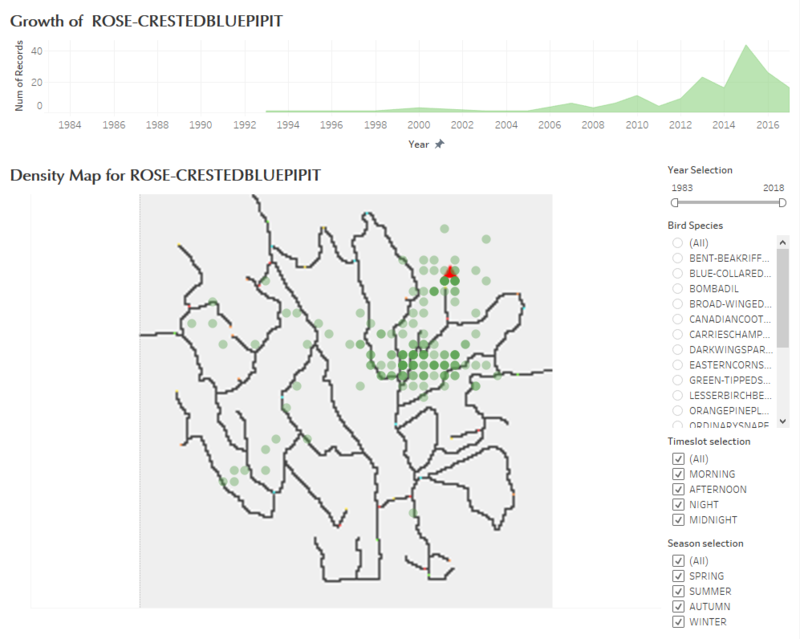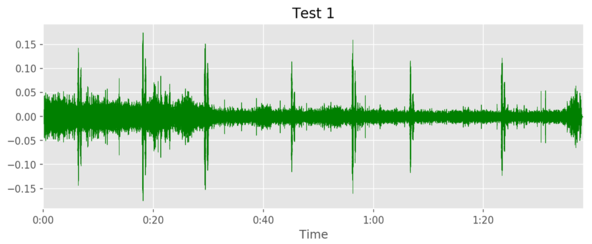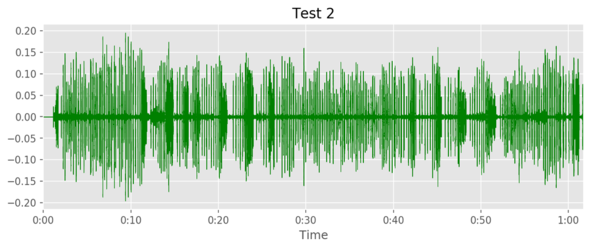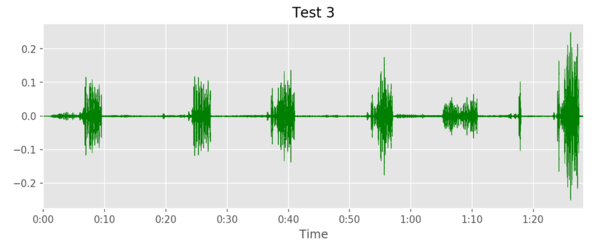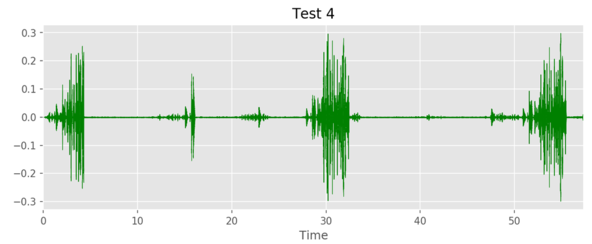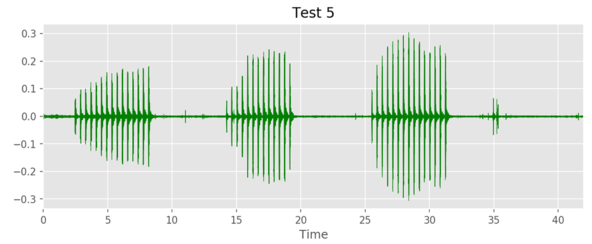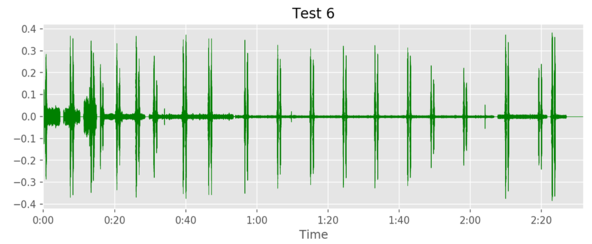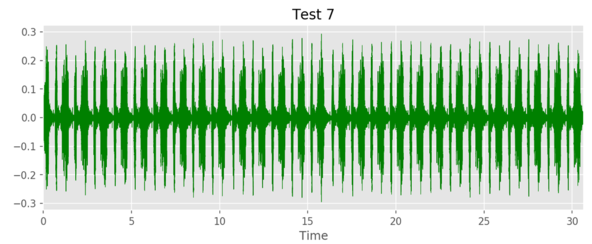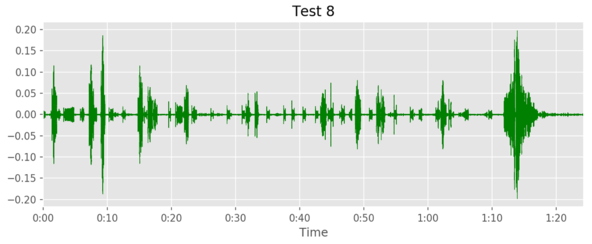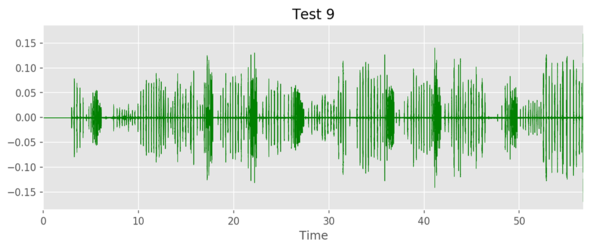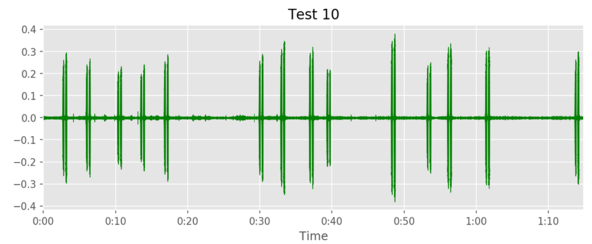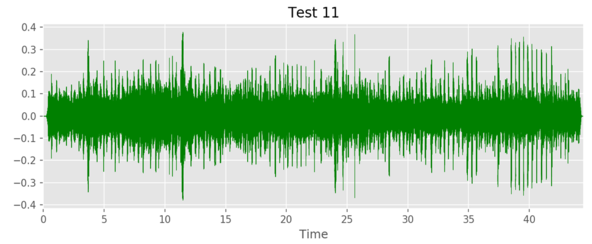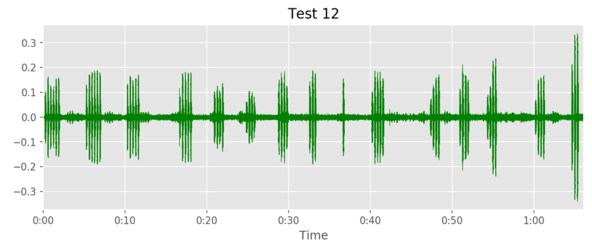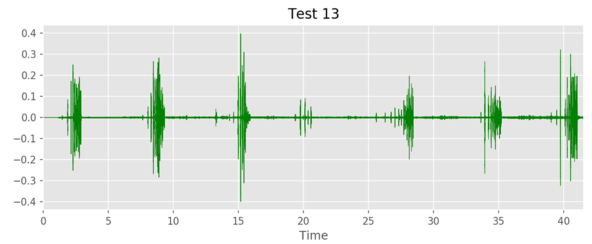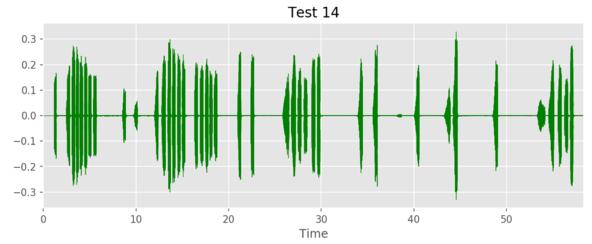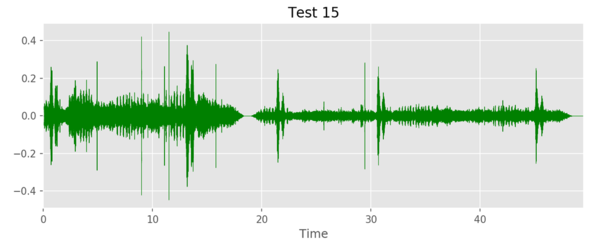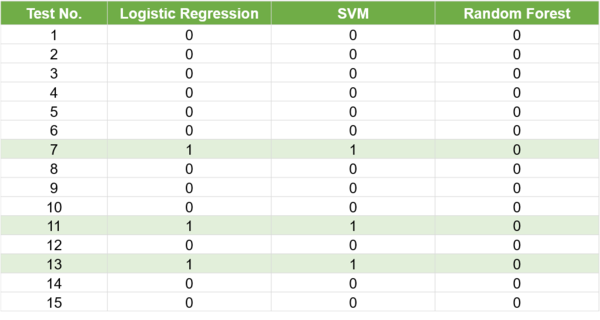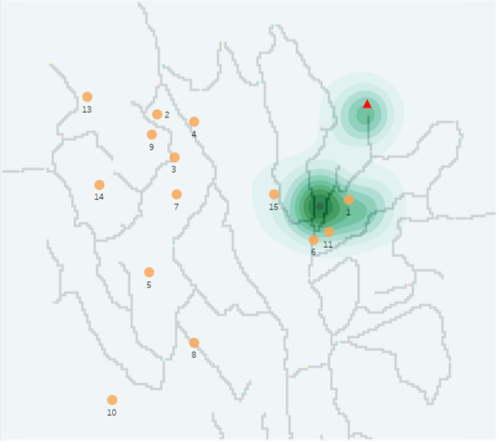Difference between revisions of "ISSS608 2017-18 T3 Assign Li Hongxin Answers"
| (18 intermediate revisions by the same user not shown) | |||
| Line 33: | Line 33: | ||
[[File:Pipit gird.gif]] | [[File:Pipit gird.gif]] | ||
| − | |||
| − | |||
| − | |||
| − | |||
| − | |||
| − | |||
<hr/> | <hr/> | ||
===Kernel Density Plot=== | ===Kernel Density Plot=== | ||
Kernel density plot was used to visualize the geographical distribution more clearly. <b>Figure below shows that during 1983-2018, there were two centers with high density distribution of Rose-crested Blue Pipits.</b> | Kernel density plot was used to visualize the geographical distribution more clearly. <b>Figure below shows that during 1983-2018, there were two centers with high density distribution of Rose-crested Blue Pipits.</b> | ||
| + | |||
[[File:Kernel_all.png|800px]] | [[File:Kernel_all.png|800px]] | ||
| Line 52: | Line 47: | ||
[[File:pipit_kernal.gif]] | [[File:pipit_kernal.gif]] | ||
| + | <br><br> | ||
| + | <hr/> | ||
| + | |||
| + | ===Growth Pattern=== | ||
| + | Area plot is a straightforward way of indicating the growth trend. From the figures below, we can conclude that the number of birds around this Preserve has a large growth from 1983 to 2017, so does the Rose-crested Blue Pipit. <b>However, the number of Rose-crested Blue Pipit has a sharp decrease from 2016</b>. This might be another evidence to show that Rose-crested Blue Pipit was influenced by the dumping site. But we still need further proof because the total number of 19 species decreased as well at the same time. | ||
| + | |||
| + | [[File:Trend_mark.png|800px]] | ||
<hr/> | <hr/> | ||
| Line 61: | Line 63: | ||
[[File:Jianloude_dashboard.png|800px]] | [[File:Jianloude_dashboard.png|800px]] | ||
| − | ==Question 2:Does the set of bird calls are Pipits== | + | |
| + | |||
| + | ==Question 2:Does the set of bird calls are Pipits?== | ||
===Audio Visualization=== | ===Audio Visualization=== | ||
First, we apply visualization to get the pattern of songs all 19 species and try to figure out whether the test birds belongs to the Rose-crested Blue Pipit. <b>That means we only care about Rose-crested Blue Pipit and we don't have to differentiate the other 18 classes</b>. | First, we apply visualization to get the pattern of songs all 19 species and try to figure out whether the test birds belongs to the Rose-crested Blue Pipit. <b>That means we only care about Rose-crested Blue Pipit and we don't have to differentiate the other 18 classes</b>. | ||
| − | ==== | + | ====I. Wave plot and Spectrogram==== |
Wave plot and spectrogram were used to visualize the sound waves of bird species. For each species, we selected one "Call" and one "Song" from the observations with Quality A as training set. Wave plot is more intuitive than the spectogram. Thus, we compared the patterns of wave plot between training birds and test birds to classify the test birds first. If the wave plot was ambiguous, we would tried to compare the spectrogram. | Wave plot and spectrogram were used to visualize the sound waves of bird species. For each species, we selected one "Call" and one "Song" from the observations with Quality A as training set. Wave plot is more intuitive than the spectogram. Thus, we compared the patterns of wave plot between training birds and test birds to classify the test birds first. If the wave plot was ambiguous, we would tried to compare the spectrogram. | ||
| Line 70: | Line 74: | ||
<br> | <br> | ||
| − | ==== | + | ====II. Comparison Results for the Test Birds ==== |
| − | < | + | By comparing the pattern of test birds and training birds, <b>test no.1,11, and 15 might belong to the Rose-crested Blue Pipit.</b> |
{| class="wikitable" style="background-color:#FFFFFF;" width="100%" | {| class="wikitable" style="background-color:#FFFFFF;" width="100%" | ||
|- | |- | ||
| Line 93: | Line 97: | ||
|- | |- | ||
| | | | ||
| − | + | 2. | |
|| | || | ||
[[File:17.png|800px]] | [[File:17.png|800px]] | ||
| Line 102: | Line 106: | ||
|- | |- | ||
| | | | ||
| − | + | 3. | |
|| | || | ||
[[File:17.png|800px]] | [[File:17.png|800px]] | ||
| Line 111: | Line 115: | ||
|- | |- | ||
| | | | ||
| − | + | 4. | |
|| | || | ||
[[File:17.png|800px]] | [[File:17.png|800px]] | ||
| Line 120: | Line 124: | ||
|- | |- | ||
| | | | ||
| − | + | 5. | |
|| | || | ||
[[File:17.png|800px]] | [[File:17.png|800px]] | ||
| Line 129: | Line 133: | ||
|- | |- | ||
| | | | ||
| − | + | 6. | |
|| | || | ||
[[File:17.png|800px]] | [[File:17.png|800px]] | ||
| Line 138: | Line 142: | ||
|- | |- | ||
| | | | ||
| − | + | 7. | |
|| | || | ||
[[File:17.png|800px]] | [[File:17.png|800px]] | ||
| Line 147: | Line 151: | ||
|- | |- | ||
| | | | ||
| − | + | 8. | |
|| | || | ||
[[File:17.png|800px]] | [[File:17.png|800px]] | ||
| Line 156: | Line 160: | ||
|- | |- | ||
| | | | ||
| − | + | 9. | |
|| | || | ||
[[File:17.png|800px]] | [[File:17.png|800px]] | ||
| Line 165: | Line 169: | ||
|- | |- | ||
| | | | ||
| − | + | 10. | |
|| | || | ||
[[File:17.png|800px]] | [[File:17.png|800px]] | ||
| Line 174: | Line 178: | ||
|- | |- | ||
| | | | ||
| − | + | 11. | |
|| | || | ||
[[File:17.png|800px]] | [[File:17.png|800px]] | ||
| Line 180: | Line 184: | ||
[[File:Test11.png|800x244px]] | [[File:Test11.png|800x244px]] | ||
|| | || | ||
| − | + | Maybe | |
|- | |- | ||
| | | | ||
| − | + | 12. | |
|| | || | ||
[[File:17.png|800px]] | [[File:17.png|800px]] | ||
| Line 192: | Line 196: | ||
|- | |- | ||
| | | | ||
| − | + | 13. | |
|| | || | ||
[[File:17.png|800px]] | [[File:17.png|800px]] | ||
| Line 201: | Line 205: | ||
|- | |- | ||
| | | | ||
| − | + | 14. | |
|| | || | ||
[[File:17.png|800px]] | [[File:17.png|800px]] | ||
| Line 210: | Line 214: | ||
|- | |- | ||
| | | | ||
| − | + | 15. | |
|| | || | ||
[[File:17.png|800px]] | [[File:17.png|800px]] | ||
| Line 220: | Line 224: | ||
<br> | <br> | ||
| + | <hr/> | ||
===Audio Classification=== | ===Audio Classification=== | ||
| + | Now pay attention to machine learning methods to classify the bird species. Similar with the visualization, we labeled the samples into 2 classes:0(not Rose-crested Blue Pipit) and 1(Rose-crested Blue Pipit). | ||
| + | For the three methods, random forest has the best performance - 98.7% for the training set and 92.3% for test set. The predicted result was also shown below. <b>By taking all three results together, test no.7, 11 and 13 were more likely to be Rose-crested Blue Pipit</b>. | ||
| + | |||
| + | [[File:Accuracy.png|600px]] | ||
| + | |||
| + | [[File:ML_result.png|600px]] | ||
| + | <br><br> | ||
<hr/> | <hr/> | ||
===Discussion=== | ===Discussion=== | ||
| + | Audio visualization can provide some additional evidence for the confirmation of machine learning results. For example, by comparing the result of visualization and of machine learning, only test no.11 was confirmed by both methods. For the test no.7 and test no.13 which were also picked by logistic regression and SVM, their patterns of waveplot were quite different with the pattern of Rose-crested Blue Pipit. And they might be allocated into wrong class. | ||
| + | |||
| + | In addition, going back to the location, the test no.11 also located at the area where Rose-crested Blue Pipit was thriving in this past. | ||
| + | Other test birds, such as test no.1 and test no.15 picked by audio visualization were close to test no.11; whereas test no.7 and test no.13 which were picked by machine learning methods were far from the thriving area, which indicated that they had slight chance to be Rose-crested Blue Pipit. | ||
| + | |||
| + | In conclusion, only one observations provided by Kasios can be confirmed as Rose-crested Blue Pipit, and two observations were similar with the Rose-crested Blue Pipit. <b>And we can say that Pipits were not found across preserve.</b> | ||
[[File:Test Birds Location.png|500px]] | [[File:Test Birds Location.png|500px]] | ||
Latest revision as of 11:57, 8 July 2018
|
|
|
|
|
Contents
Question 1: Are Pipits actually thriving across the Preserve?
Geographical Distribution Overview
Birds were found throughout the preserve as shown in the left figure. The darker, the more birds were found around the area. Figure in the right indicates the geographical distribution of Rose-crested Blue Pipit. That is, at the northeast of the Preserve, and near to the Dumping Site(shown as red triangle).
From the dynamic graph, we can find that the gathering place of Rose-crested Blue Pipit moved around the northeast corner of the Preserve from 2007 to 2017. And the path of the moving went to the red triangle direction, where the dumping site located in the recent years, and then to the opposite direction. This may provide an evidence that the dumping site has some effect on the Rose-crested Blue Pipit.
Kernel Density Plot
Kernel density plot was used to visualize the geographical distribution more clearly. Figure below shows that during 1983-2018, there were two centers with high density distribution of Rose-crested Blue Pipits.
If we take look at the kernel density plot over the recent years(from 2012 to 2017), it is obvious that there were 2 centers at the beginning, and then the center near the location where dumping site was built later gathered more Pipits. But eventually, the density of this center kept decreasing from 2015 and now only one center exists for the Pipits.
You may refer to the dynamic graph to have an intuitive feelings. If the dumping site was built around 2014 or 2015, it is more likely that the Rose-crested Blue Pipit was influenced by the dumping site.
Growth Pattern
Area plot is a straightforward way of indicating the growth trend. From the figures below, we can conclude that the number of birds around this Preserve has a large growth from 1983 to 2017, so does the Rose-crested Blue Pipit. However, the number of Rose-crested Blue Pipit has a sharp decrease from 2016. This might be another evidence to show that Rose-crested Blue Pipit was influenced by the dumping site. But we still need further proof because the total number of 19 species decreased as well at the same time.
Interactive Dashboard
Interactive dashboard is created for users to find out some interesting patterns of bird species by themselves.
The upper side of the dashboard is an area plot, which shows the growth trend of one bird species or all birds in the Preserve. The bottom of the dashboard is a scatter density plot, where we change the grid from 1x1 to 5x5 to show the density of birds around the Preserve.
The controller in at the right side allow users to select Year/Bird Species/Season/Timeslot.
Question 2:Does the set of bird calls are Pipits?
Audio Visualization
First, we apply visualization to get the pattern of songs all 19 species and try to figure out whether the test birds belongs to the Rose-crested Blue Pipit. That means we only care about Rose-crested Blue Pipit and we don't have to differentiate the other 18 classes.
I. Wave plot and Spectrogram
Wave plot and spectrogram were used to visualize the sound waves of bird species. For each species, we selected one "Call" and one "Song" from the observations with Quality A as training set. Wave plot is more intuitive than the spectogram. Thus, we compared the patterns of wave plot between training birds and test birds to classify the test birds first. If the wave plot was ambiguous, we would tried to compare the spectrogram.
II. Comparison Results for the Test Birds
By comparing the pattern of test birds and training birds, test no.1,11, and 15 might belong to the Rose-crested Blue Pipit.
|
Bird No. |
Wave plot of Rose-crested Blue Pipit |
Wave plot of Test Bird |
Similar with Rose-crested Blue Pipit? |
|
1. |
Yes | ||
|
2. |
No | ||
|
3. |
No | ||
|
4. |
No | ||
|
5. |
No | ||
|
6. |
No | ||
|
7. |
No | ||
|
8. |
No | ||
|
9. |
No | ||
|
10. |
No | ||
|
11. |
Maybe | ||
|
12. |
No | ||
|
13. |
No | ||
|
14. |
No | ||
|
15. |
Yes |
Audio Classification
Now pay attention to machine learning methods to classify the bird species. Similar with the visualization, we labeled the samples into 2 classes:0(not Rose-crested Blue Pipit) and 1(Rose-crested Blue Pipit).
For the three methods, random forest has the best performance - 98.7% for the training set and 92.3% for test set. The predicted result was also shown below. By taking all three results together, test no.7, 11 and 13 were more likely to be Rose-crested Blue Pipit.
Discussion
Audio visualization can provide some additional evidence for the confirmation of machine learning results. For example, by comparing the result of visualization and of machine learning, only test no.11 was confirmed by both methods. For the test no.7 and test no.13 which were also picked by logistic regression and SVM, their patterns of waveplot were quite different with the pattern of Rose-crested Blue Pipit. And they might be allocated into wrong class.
In addition, going back to the location, the test no.11 also located at the area where Rose-crested Blue Pipit was thriving in this past. Other test birds, such as test no.1 and test no.15 picked by audio visualization were close to test no.11; whereas test no.7 and test no.13 which were picked by machine learning methods were far from the thriving area, which indicated that they had slight chance to be Rose-crested Blue Pipit.
In conclusion, only one observations provided by Kasios can be confirmed as Rose-crested Blue Pipit, and two observations were similar with the Rose-crested Blue Pipit. And we can say that Pipits were not found across preserve.
